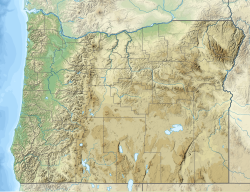| Hudspeth Formation | |
|---|---|
| Stratigraphic range: Albian-Cenomanian ~ [1] | |
| Type | Geological formation |
| Unit of | Mitchell Group |
| Area | Wheeler & Lake Counties, Oregon |
| Lithology | |
| Primary | Mudstone, shale |
| Location | |
| Coordinates | 43°18′N120°06′W / 43.3°N 120.1°W |
| Approximate paleocoordinates | 42°54′N74°48′E / 42.9°N 74.8°E |
| Region | Oregon |
| Country | United States |
The Hudspeth Formation is a Cretaceous sedimentary rock formation, found in Oregon of the United States of America. The formation dates to the Albian age of the Early Cretaceous period. During the Albian much of this formation was submerged beneath shallow seas resulting in the preservation of many marine fossils. Pterosaur, dinosaur and marine fossils have been recovered from the formation. It is intertongued with the Gable Creek Formation. [2]





